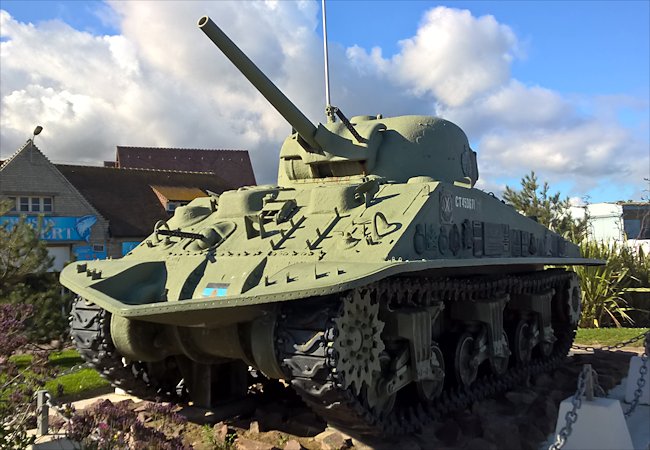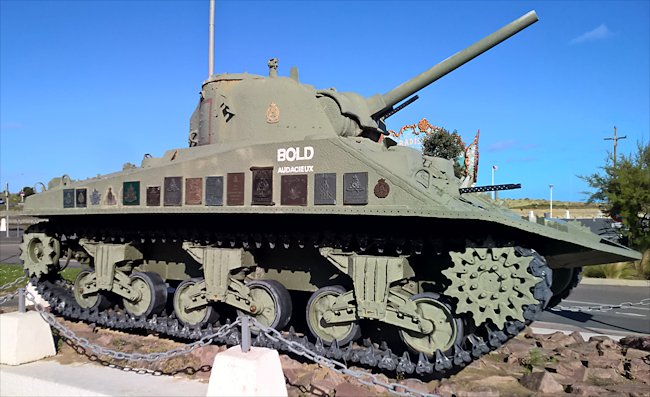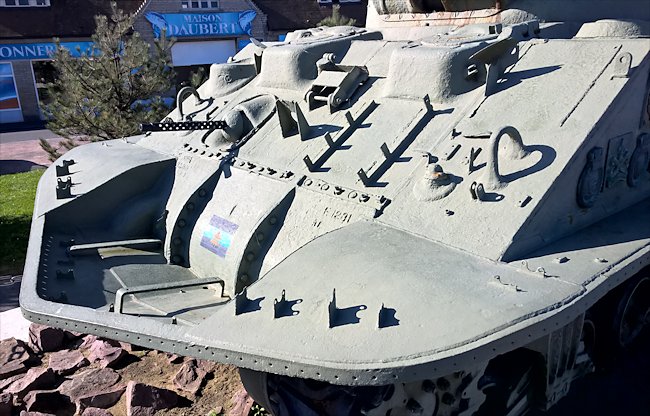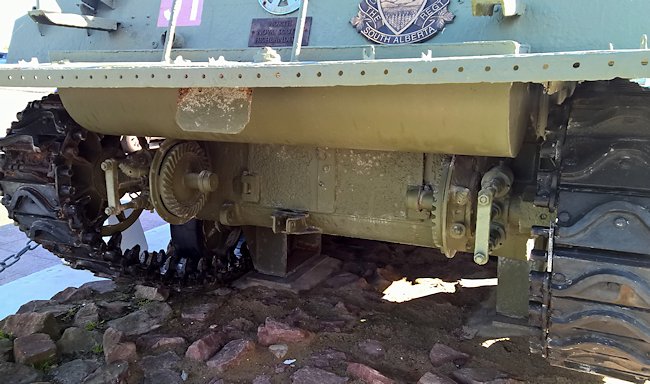Courseulles-sur-Mer Sherman M4A4(75) DD Tank
The M4A4 version of the Sherman tank first saw combat with the 12th Canadian Tank Regiment in an assault landing at Pachino Bay in Sicily 10th July 1943. M4A4 tanks were assigned to British and Commonwealth tank regiments under the lend lease agreement. They made up the bulk of the Commonwealth 75mm Sherman tanks used in Normandy.

M4A4(75) Sherman Duplex Drive Juno Beach Memorial tank in Courseulles-sur-Mer, Normandy
Location
To find this tank head towards the long fishing harbour and drive along the east side road the Quai des Allies. At the end of the road near the coast the road bends around and comes to a crossroads at the junction with the Place du 6 Juin.
The Sherman DD tank is on the corner surrounded by flowers. What is fascinating about this tank is that the metal skirt of the DD is still attached to the tanks hull. The rear propellers have been removed but the transmission gears can still be seen. The tank is covered with metal military plaques that belonged to the military units that landed on this section of the D-Day Coast.
Specification
The M4A4 version of the Sherman tank was powered by a petrol Chrysler A57 multibank 30 cylinder 21 liter engine that produced 470 hp. This gave the tank a maximum road speed of around 25 - 30 mph (40 - 48 km/h).It could carry 660 litres of fuel and had an operational range of around 120 miles (193 km) before it needed to refuel. It was armed with a 75 mm M3 L/40 gun and two .30-60 Browning machine guns: one in the hull and another in the turret next to the main gun.
It was manufactured at the Detroit Tank Arsenal in America. Records show that 7,499 of this version of the Sherman tank were produced between July 1942 and November 1943. The tank's armour thickness ranged from 25 mm to 76 mm on the front. It needed a five man crew: Commander, driver, gunner, loader and co-driver/machine gunner.

The metal military plaques on the side of this Sherman DD tank belonged to the military units that landed on this section of the D-Day Coast.
Deployment in Normandy 1944
The planning started in 1943 for the launching of a massive invasion on the French Coast. Every one knew that it was going to be a very difficult operation to land thousands of men and equipment from the sea onto a beach under heavy fire. The Germans were expecting the attack and held a strong defensive position and had built lots of beach obstacles designed to blow up any ship on impact or rip out the ships bottom.
It was clear that tank design had to be rethought. They had to be altered and given specific tasks like mine clearing, bridge laying, bulldozing, flame throwing or concrete bunker destruction. The troops landing on the beaches would need tank support fast. The idea was suggested of making tanks swim ashore. The engineers came up with the Sherman tank duplex drive DD (or Donald Duck tank).

The DD canvas was attached to this boat shaped metal platform welded to the tank hull.
It was 30 tonnes of iron and steel that had been adapted to float. The planners worry was that if you put lots of tanks on a few tank landing craft ships and they all got hit by the big German Naval guns that guarded the approaches to the beaches the troops would be without tank support. They loved the idea of the floating swimming tank as it spread the risk of losses. The tanks would slip into the water a few miles out to sea and head to wards the shore. Each tank would be a smaller target to hit.
The whole idea behind the Duplex Drive tanks was the science of displacement. If you can push out enough water, roughly 30 tonnes of water, the same weight of the Sherman tank, then the tank will float. The height and volume of the screen installed around the outside of the Sherman tank was calculated to be the correct amount to displace the required quantity of seawater. Propellers were added at the back of the tank to propel the tank to shore at around 3 miles an hour. Once the tank was on the beach the canvas screen would be collapsed and the tank would be able to engage enemy targets.

Two propeller drives were added at the rear of the tank and two propellers were fixed onto the drive units. You can still see the gear mountings at the back of the tank.
To transform a Sherman tank to a seaworthy machine it had to undergo a dramatic transformation. The lower hull was sealed. Two propeller drives were added at the rear of the tank and two propellers were fixed onto the drive units. The base of the canvas screen was attached to a new metal boat shaped platform that went around the tanks hull. It was welded in place.
The water tight canvas screen was supported in place by a number of boat shaped metal hoops that were lifted into place by 36 vertical inflatable rubber tubes. A system of compressed air bottles were used to inflate the rubber tubes to give the canvas curtain rigidity. Additional metal hinged arms and props were attached to the tank hull to assist keeping the canvas in the correct position when it was in the extended position. It took 15 minutes to erect the screen to full operational height.
The screen could be quickly collapsed once the tank reached the shore by just turning a tap and letting out the air in the rubber tubes. Very little of the parts used to construct the DD tank screens were made from scratch. Existing commercial parts used in building lorries, boats and trains were ordered and just put together in an unusual way. This kept production cost and timing down to the minimum.
The propellers and the propeller drive units were designed to be raised into a locked position for when the tank had reached dry land and needed to drive across country. This procedure took it out of gear and the propellers would no longer turn. For the initial run ashore a member of the crew would be outside the tank at the rear. He would operate a large metal pole that acted as a ships tiller so that the floating tank could be steered. When the tank got near the enemy shore the tiller would be removed and crew member got back into the tank. The driver would then take over once the tracks touched down on the beach. Records show that the British converted 639 Sherman tanks into DD tanks from March 1944 and up to December 1944.
A heavy swell in rough water could come over the top of the canvas and flood the tank sending it down to the bottom. Weather conditions on D-Day 6th June 1944 were rough. Many of the tanks launched failed to reach the beach because of the very rough seas and being launched too far out from the coast. Only two American Sherman DD tanks reached shore. The British 'Donald Duck' tanks were launched closer to the shore and more were able to reach the beach.
British DD Sherman tank crew veteran's memories
Second World War Veteran Bill Wright's Duplex Drive swimming Sherman Tank that he crewed to cross the Rhine River is now preserved at the Tank Museum Bovington, England. At the age of 19, Radio Operator, Bill Wright from B Squadron, of the Staffordshire Yeomanry, embarked on his first action of the Second World War. He and the rest of his crew landed on Sword Beach, at 10.30am in a Sherman tank prepared for deep wading. Bill remembered 'We were conscious we were making history'.
Having survived the Normandy battles, Bill returned to England with his regiment to train on Duplex Drive Sherman Tanks at Fritton Lake, near Great Yarmouth. In October 1944 he took part in the amphibious landing on South Beveland in the Scheldt estuary, which opened up the port of Antwerp to Allied shipping. This involved a 'swim' of seven miles in the open estuary, a record for DD tanks which still stands.
His last major action was the Rhine crossing in March 1945, again in a Sherman DD. Shortly after landing his tank was knocked out, but thankfully all the crew survived and re-equipped with a 17-pdr Sherman Firefly which they kept until the final surrender the following May.
Asked for his opinion on the Sherman DDs, Bill said, 'Although they may have looked the funniest of all General Hobart's 'Funnies' they were in fact a brilliant, simple, effective answer to the problem of making a 30-ton tank float and able to navigate in open water without compromising its fighting ability on land. Their contribution to final victory deserves to be remembered.'
Where can I find other preserved Sherman Duplex Drive Tanks?
- M4A1(75) DD - The Tank Museum, Bovington, England
- M4A1(75) DD - Exercise Tiger Memorial, Torcross, England
- M4A1(75) DD - Musee des Blindes, French Tank Museum, Saumur, France
- M4A1(75) DD Small Hatches - D-Day Underwater Wrecks Museum, Commes, France
- M4A1(75) DD large Hatches - D-Day Underwater Wrecks Museum, Commes, France
- M4A4(75) DD - Juno Beach, Courseulles-sur-Mer, France
- M4A4(75) DD - Rixheim, France
- M4A1(75) DD - Piana delle Orme Museum, Italy
- M4A2(75) DD - Armoured Corps Museum, Ahmednagar, Maharashtra, India
- M4A2(75) DD - Jaisalmer War Museum, Jaisalmer, India
- M4A2(75) DD - Mandoli (near Belgaum), Karnataka, India
- M4A2E8 DD - U.S. Army Center for Military History Storage Facility Anniston, AL, USA
D-Day 1944 books

